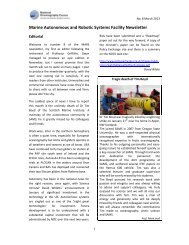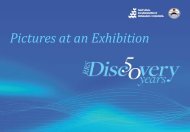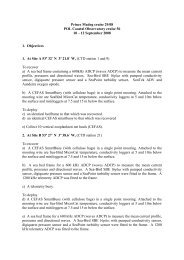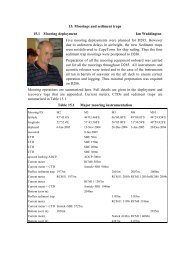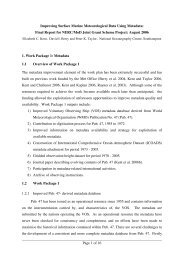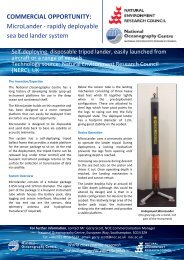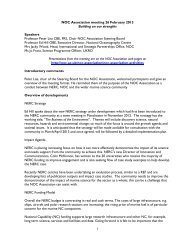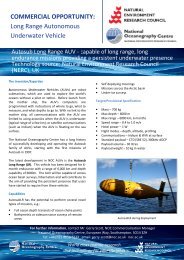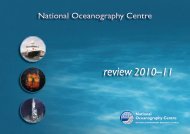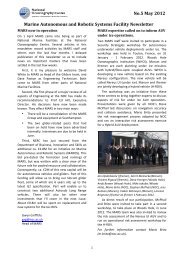Cruise report - Coastal Observatory, Liverpool Bay, Irish Sea
Cruise report - Coastal Observatory, Liverpool Bay, Irish Sea
Cruise report - Coastal Observatory, Liverpool Bay, Irish Sea
Create successful ePaper yourself
Turn your PDF publications into a flip-book with our unique Google optimized e-Paper software.
<strong>Sea</strong>-Bird 16plus S/N 4596 on base of frame with pumped conductivity sensor underneath.<strong>Sea</strong>point turbidity sensor S/N 10320 taped to roll bar. The calibration CTD cast will beperformed after recovery.Sample interval 600 s; diqiquartz integration time 40 s (Paros unit=40)1 s delay before sampling, pump on for 0.5 s before sampling.Clock set at 15:10:20 on 28 October; delayed start at 12:00:00 on 29 October 2004.<strong>Sea</strong>-Bird MicroCAT temperature, conductivity recorder S/N 2081 on spider (ID=02).10 minute sampling. Reference pressure 25db.Clock set at 14:13:05 on 28 October 2004; delayed start at 06:00:00 on 29 October 2004.The frame D2 was fitted with two Benthos releases 70354 - 13.0 kHz enable C, release D and70355 – 10.0 kHz enable C, release D both with a fizz link, and a spooler with 200m of ropefor recovery of the ballast weight.f) SmartBuoy Mooring.<strong>Sea</strong>-Bird MicroCAT temperature, conductivity and pressure recorder (2010 – ID=01) at 5 mbelow the surface. 10 minute samples. Reference pressure 25 db.Clock set at 14:23:20 on 28 October 2004. Delayed start 06:00:00 on 29 October 2004.Aanderaa current meter RCM7 9631 / DSU 8117 without fin at 10 m below the surface to logtemperature (low temperature setting) and conductivity: 10 minute samples.Started at 14:40:00 on 28 October 2004.The CEFAS SmartBuoy is fitted with two surface CTDS, light sensors at 1 and 2 m below thesurface, a water sampler which obtains water samples once per day for laboratory nutrient(nitrate, nitrite, phosphate) determination and an in situ NAS2E nutrient analyser. The CTDand light data are transmitted back to CEFAS via Orbcomm.The single point mooring was composed mainly of ½" long link chain, marked by a 1.8 mdiameter toroid and anchored by a half tonne clump of scrap chain.g) Telemetry ADCP 1200 kHz RDI 0572.Battery case 0254 fitted with part used batteries.Mode 1: 100 pings every 10 minutes (velocity standard deviation 0.003 m s -1 ).30 x 1 m bins (2.15 – 31.15 m above the bed).Earth co-ordinates - speeds, correlation, echo intensity, % good.Sound velocity calculated from temperature, depth and salinity of 32.1 GByte memory.Clock reset at 15:57:15 on 29 October, delayed start 06:50:00 on 30 October 2004. OK.The ADCP recorded 10 minutes averages internally and sent a sub-set of east & northcomponent data (PD12 format) every hour (on the hour) via a LinkQuest modem to thetelemetry buoy. LinkQuest recommend that the acoustic modem should not be used in air atfull power. Therefore it was plugged into its battery pack just before deployment.The frame was fitted with two Benthos releases 6976 - 11.5 kHz 5A, enable F, release D and70356 10.5 kHz enable C, release D both with fizz link, and a spooler with 200m of rope forrecovery of the ballast weight.6
h) Telemetry buoyA LinkQuest acoustic modem and battery pack, a GPS receiver and an Orbcomm satellitesystem and battery pack were fixed to a toroid. The Orbcomm system was setup to send e-mails once an hour, containing data from the ADCP (Format PD12) received by the acousticmodem link.The single point mooring was composed mainly of ½" long link chain, marked by a 1.8 mdiameter toroid and anchored by a half tonne clump of scrap chain. 3m chain added beneathbuoy to aid recovery.Table 2. Deployed mooring positions and times.Latitude Longitude Water Deployment(N) (W) Depth Time Date(m)(Wave buoy 53º 32.171´ 3º 21.522´)Waves ADCP 53º 31.954´ 3º 21.993´ 28.5 11:52 29/10/04SmartBuoy 53º 31.992´ 3º 22.146´ 28.2 12:14 29/10/04Telemetry toroid 53º 32.046´ 3º 22.507´ 26.3 09:03 30/10/04Telemetry ADCP 53º 31.876´ 3º 22.418´ 27.0 09:09 30/10/045. CTDThe <strong>Sea</strong>-Bird 911 CTD recorded downwelling PAR light levels (CEFAS light sensor),temperature, conductivity, transmittance, oxygen (no calibration samples) and fluorescence at24 Hz. The frame was fitted with an altimeter, which was not totally reliable, so thatmeasurements were taken to within an estimated 3 m above the bed. Two water bottles werefired near bed and two near the surface, when needed. One of the near bed bottles was fittedwith two electronic thermometers to check the CTD temperature data. Water samples weretaken from this bottle for calibration of the CTD salinity data. (At the CEFAS stations, seebelow, this bottle was fired near the surface). Water samples were taken from the nearsurface and near bed bottles and frozen for nutrient analysis by SOC (nitrate, phosphate,silicate), and also were filtered to determine suspended sediment load and calibrate the CTDtransmissometer, by the School of Ocean Sciences. Water samples from the second nearsurface bottle from stations 1, 5 – 9 and 11 were filtered for chlorophyll and suspendedsediment determination and some filtrate was preserved with mercuric chloride for nutrientdetermination by CEFAS. A LISST-25 particle sizer was fitted to the CTD and its datalogged on the <strong>Sea</strong>-Bird data logging system. A LISST-100 particle sizer with internallogging was also attached to the CTD frame and its data periodically downloaded for analysisby SOS. Copies of the <strong>Sea</strong>-Bird binary files were taken off for processing and calibration atBODC / POL.7
Table 3. Nominal CTD positions.Site Latitude Longitude Visited on Chlorophyll Suspended Grab &(N) (W) this cruise & nutrients Sediments / waternutrients sample1 53º 32´ 3º 21.8´ yes yes yes yes2 53º 37´ 3º 13.4´ yes yes3 53º 42´ 3º 13.4´ yes yes4 53º 47´ 3º 13.4´ yes yes5 53º 52´ 3º 21.8´ yes yes yes yes6 53º 47´ 3º 21.8´ yes yes yes yes7 53º 42´ 3º 21.8´ yes yes yes yes8 53º 37´ 3º 21.8´ yes yes yes yes9 53º 32´ 3º 21.8´ yes yes yes10 53º 27´ 3º 13.4´ yes yes11 53º 27´ 3º 21.8´ yes yes yes yes12 53º 27´ 3º 30.2´ yes yes yes13 53º 32´ 3º 30.2´ yes yes yes14 53º 37´ 3º 30.2´ yes yes yes15 53º 42´ 3º 30.2´ yes yes yes16 53º 47´ 3º 30.2´ yes yes yes17 53º 47´ 3º 38.6´ yes yes18 53º 42´ 3º 38.6´ yes yes19 53º 37´ 3º 38.6´ yes yes20 53º 32´ 3º 38.6´ yes yes yes21 53º 27´ 3º 38.6´ yes yes yes22 53º 23´ 3º 38.6´ yes yes23 53º 23´ 3º 47.0´ yes yes yes24 53º 27´ 3º 47.0´ no25 53º 32´ 3º 47.0´ yes yes26 53º 37´ 3º 47.0´ yes yes yes27 53º 42´ 3º 47.0´ yes yes yes28 53º 47´ 3º 47.0´ yes yes29 53º 47´ 3º 55.4´ yes yes30 53º 42 3º 55.4´ yes yes yes31 53º 37´ 3º 55.4´ yes yes32 53º 32´ 3º 55.4´ yes yes yes33 53º 27´ 3º 55.4´ yes yes yes34 53º 22´ 3º 55.4´ yes yes35 53º 32´ 3º 15.9´ yes yes6. Surface samplingThe intake for the surface sampling system is located underneath RV Prince Madog, at about3 m below sea level. The parameters recorded every minute by the WS Oceans system are:Date, Solar Radiation (W m -2 ), PAR (µmols / m 2 s), Air Temperature (ºC), Relative Humidity,Relative Wind Speed (m s -1 ), Relative Wind Direction (º) – zero indicates wind on the bow,Transmissance, Hull Temperature (ºC), Barometric Pressure (mbar), Fluorescence, Turbidity,Salinity, Minimum Air Temp (ºC), Maximum Air Temp (ºC), Wind Gust (m s -1 ), GPS Time,8
Latitude, Longitude, Barometric Pressure Minimum (mbar), Barometric Pressure Maximum(mbar), Conductivity sensor water temperature (ºC). <strong>Sea</strong> surface temperature, salinity andtransmittance were calibrated against the CTD by BODC.Data were recorded every minute from 08:27 on 29 October until 14:46 on 30 Octoberstarting and ending at Puffin Island. The pump was not switched on until 13:48 on 29October and there was a gap between 04:21 and 05:41 on 30 October. Copies of the datawere taken off the ship as an Excel file, along with a copy of the ship’s navigation data.The ship was fitted with a 300 kHz ADCP set to record 25 x 2m bins, the bin nearest thesurface was at 5.1 m depth, every 30 seconds with 29 pings / ensemble. Data were recordedbetween 08:28 on 29 October and 14:46 on 30 October. There appeared to no problems withdata recording on this cruise.AcknowledgementsThe assistance of the Captain, officers, bosun, and crew contributed greatly to the success ofthe cruise.9



